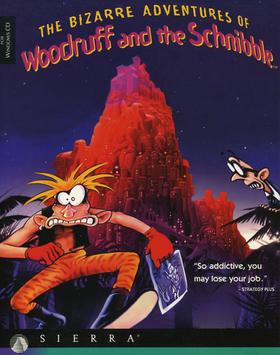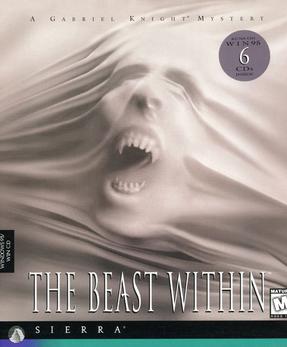
Loom is a 1990 fantasy-themed graphic adventure game by Lucasfilm Games. The project was led by Brian Moriarty, a former Infocom employee and author of classic text adventures Wishbringer (1985), Trinity (1986), and Beyond Zork (1987). It was the fourth game to use the SCUMM adventure game engine, and the first of those to avoid the verb–object interface introduced in Maniac Mansion.
Magnetic Scrolls was a British video game developer active between 1984 and 1990. A pioneer of audiovisually elaborate text adventure games, it was one of the largest and most acclaimed interactive fiction developers of the 1980s, and one of the "Big Two" with Infocom according to some.

The Single Integrated Operational Plan (SIOP) was the United States' general plan for nuclear war from 1961 to 2003. The SIOP gave the President of the United States a range of targeting options, and described launch procedures and target sets against which nuclear weapons would be launched. The plan integrated the capabilities of the nuclear triad of strategic bombers, land-based intercontinental ballistic missiles (ICBM), and sea-based submarine-launched ballistic missiles (SLBM). The SIOP was a highly classified document, and was one of the most secret and sensitive issues in U.S. national security policy.

Dune is a 1992 adventure strategy game based on the 1965 novel of the same name by Frank Herbert. It was developed by Cryo Interactive and published by Virgin Interactive.

Trinity is an interactive fiction video game written by Brian Moriarty and published in 1986 by Infocom. It is widely regarded as one of the company's best works.

It Came from the Desert is a 1989 action-adventure game by Cinemaware. It was originally released for the Amiga, but later ported to MS-DOS, as well as released in distinctly different forms to consoles. The TurboGrafx-16 release is distinctly different from the computer versions, in terms of gameplay and presentation. An expansion set Antheads: It Came from the Desert II was released in 1990.
A government simulation or political simulation is a game that attempts to simulate the government and politics of all or part of a nation. These games may include geopolitical situations, the creation of domestic political policies, or the simulation of political campaigns. They differ from the genre of classical wargames due to their discouragement or abstraction of military or action elements.

Beyond Castle Wolfenstein is a 1984 World War II stealth game. A direct sequel to Castle Wolfenstein, it is the second game in the Wolfenstein series, and the last installment to be released by original developer Muse Software before the name was revived for a first-person shooter in 1991. Castle Wolfenstein was written solely by Silas Warner for the Apple II, while the sequel was developed simultaneously for the Apple II and Commodore 64 by Warner, Eric Ace, and Frank Svoboda III. It was quickly ported to the Atari 8-bit computers and MS-DOS.

Woodruff and the Schnibble of Azimuth is a 1995 French adventure game developed by Coktel Vision. The creator of the Gobliiins series, Pierre Gilhodes, worked on the game, and Woodruff shares that series' visual style, gameplay and offbeat humor, though is not an official part of the Gobliiins series or canon.

Bill & Ted's Excellent Video Game Adventure is an action-adventure video game that is part of the Bill & Ted franchise and is based on the film Bill & Ted's Excellent Adventure. It was released in North America by LJN for the Nintendo Entertainment System in 1991. The plot is an original continuation to the film's events.

Rama is a point and click adventure game, developed and published by Sierra On-Line, and released on DOS and Microsoft Windows in 1996; PlayStation version was released in 1998, but exclusively in Japan. The game is based upon Arthur C. Clarke's books Rendezvous with Rama and Rama II, combining elements of their plots with a story that sees the player assuming the role of a replacement crew member for an expedition to investigate an interstellar ship and uncover its mysteries.

Space Quest III: The Pirates of Pestulon is a 1989 graphic adventure game by Sierra On-Line, and the third game in the Space Quest series. Players assume the role of Roger Wilco, a lowly space janitor, who becomes involved in rescuing a pair of computer programmers from a sinister video game company. The game received positive reviews from critics, and contributed further to the series' commercial success for Sierra. A sequel, Space Quest IV, was released in 1991.

The Beast Within: A Gabriel Knight Mystery is a point-and-click adventure game, created by Jane Jensen, developed and published by Sierra On-Line, and released for MS-DOS, Macintosh, and Microsoft Windows, in 1995. The sequel to 1993's Gabriel Knight: Sins of the Fathers, the game's story focuses on a new investigation for Gabriel Knight, adjusting to his new life as a "shadow hunter", as he investigates a spate of killing around Munich believed to be the work of a werewolf, with assistance in his work from Grace Nakimura, who looks into a link between the killings and the final years of a Bavarian king in the 19th century.

Invasion Orion is a 1979 science fiction strategy game written and published by Automated Simulations. It is one or two player sequel to the original two-player Starfleet Orion which was published in late 1978. The game was written in BASIC for the Commodore PET and TRS-80 and ported to the Atari 8-bit computers and Apple II.

Radical Computer Music is a concept developed by the Danish experimental composer Goodiepal referring to, fundamentally, music notated not by computer networks but for computer networks, as a gesture towards the machine and the artificial intelligence expected to develop from it. Goodiepal coined the term while he was a teacher of composition at the Royal Academy of Music in Aarhus, Denmark, between 2004 and 2008, and he especially developed the project Mort Aux Vaches Ekstra Extra, which is a compositional game scenario questioning the role of the composer, time, notation and media, to thoroughly demonstrate the concept.

Wolfenstein: The New Order is a 2014 action-adventure first-person shooter video game developed by MachineGames and published by Bethesda Softworks. It was released on 20 May 2014 for PlayStation 3, PlayStation 4, Windows, Xbox 360, and Xbox One. The game is the sixth main entry in the Wolfenstein series, set in an alternate history 1960s Europe where the Nazis won the Second World War. The story follows war veteran William "B.J." Blazkowicz and his efforts to stop the Nazis from ruling over the world.
A video game walkthrough is a guide aimed towards improving a player's skill within a particular video game and often designed to assist players in completing either an entire video game or specific elements. Walkthroughs may alternatively be set up as a playthrough, where players record themselves playing through a game and upload or live-stream it to the internet. Walkthroughs may be considered guides on helping to enhance the experience of players, to assist towards unlocking game achievements or simply as a means to socialise with like-minded individuals as a distraction from everyday life.

Ralph Stock is a German game designer. He is best known for his video games Mad TV and Emergency.
















